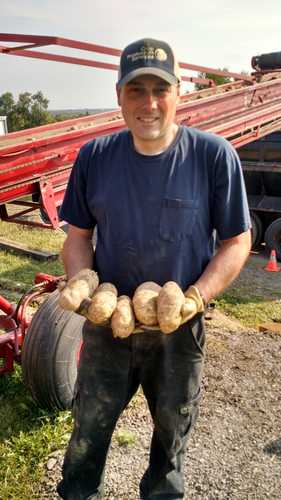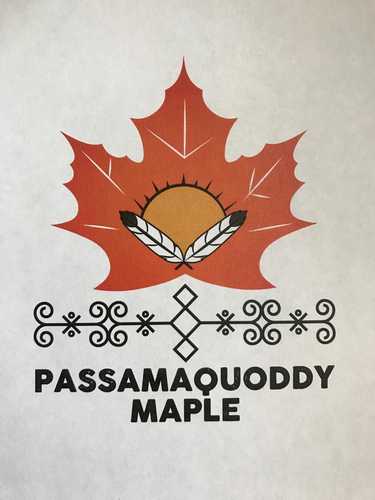Keywords: Produce
Item 16023
Maine Special potato bag, Presque Isle, ca. 1950
Contributed by: Southern Aroostook Agricultural Museum Date: circa 1950 Location: Presque Isle Media: Paper
Item 16039
Always Fresh potato bag, Caribou, ca. 1975
Contributed by: Southern Aroostook Agricultural Museum Date: circa 1975 Location: Caribou Media: Paper
Item 37344
253-263 Commercial Street, Portland, 1924
Owner in 1924: Hannaford Bros. Cco. Use: Wholesale Fruit
Item 37295
126 Commercial Street, Portland, 1924
Owner in 1924: Marcia W Rackleff Use: Storage - Produce
Item 110141
Hannaford Brothers produce warehouse, Portland, 1919-1920
Contributed by: Maine Historical Society Date: 1919–1920 Location: Portland Client: Hannaford Brothers Company Architect: John Calvin Stevens John Howard Stevens Architects
Item 148190
Walch Publishing parking plan, Portland, ME, 1991-1999
Contributed by: Maine Historical Society Date: 1991–1999 Location: Portland Client: Walch Properties Architect: Allied Architects & Engineers
Exhibit
Walter Wyman's vision to capture the power of Maine's rivers to produce electricity led to the formation of Central Maine Power Co. and to a struggle within the state over what should happen to the power produced by the state's natural resources.
Exhibit
Yarmouth's "Third Falls" provided the perfect location for papermaking -- and, soon, for producing soda pulp for making paper. At the end of the 19th century and beginning of the 20th, Yarmouth was an international leader in soda pulp production.
Site Page
Presque Isle: The Star City - Agriculture
"… lumber industry or as an exporter of agricultural produce to the nation, agriculture has always been at the center of Presque Isle's productivity."
Site Page
Presque Isle: The Star City - Maine Special potato bag, Presque Isle, c. 1950
"… Museum Description 25 pound potato bag, Produce Distributors, Inc. In the 1940s potato farmers started packaging their potatoes in…"
Story
The future of potato growing
by Dan Blackstone
Informed by six generations of potato farming
Story
The centuries-long history of Passamaquoddy Veterans
by Donald Soctomah, Passamaquoddy Historic Preservation Office
Passamaquoddy Veterans Protecting the Homeland
Lesson Plan
Grade Level: 3-5, 6-8, 9-12
Content Area: Social Studies, Visual & Performing Arts
"In the four quarters of the globe, who reads an American book?" Englishman Sydney Smith's 1820 sneer irked Americans, especially writers such as Irving, Cooper, Hawthorne, and Maine's John Neal, until Henry Wadsworth Longfellow's resounding popularity successfully rebuffed the question. The Bowdoin educated Portland native became the America's first superstar poet, paradoxically loved especially in Britain, even memorialized at Westminster Abbey. He achieved international celebrity with about forty books or translations to his credit between 1830 and 1884, and, like superstars today, his public craved pictures of him. His publishers consequently commissioned Longfellow's portrait more often than his family, and he sat for dozens of original paintings, drawings, and photos during his lifetime, as well as sculptures. Engravers and lithographers printed replicas of the originals as book frontispiece, as illustrations for magazine or newspaper articles, and as post cards or "cabinet" cards handed out to admirers, often autographed. After the poet's death, illustrators continued commercial production of his image for new editions of his writings and coloring books or games such as "Authors," and sculptors commemorated him with busts in Longfellow Schools or full-length figures in town squares. On the simple basis of quantity, the number of reproductions of the Maine native's image arguably marks him as the country's best-known nineteenth century writer. TEACHERS can use this presentation to discuss these themes in art, history, English, or humanities classes, or to lead into the following LESSON PLANS. The plans aim for any 9-12 high school studio art class, but they can also be used in any humanities course, such as literature or history. They can be adapted readily for grades 3-8 as well by modifying instructional language, evaluation rubrics, and targeted Maine Learning Results and by selecting materials for appropriate age level.
Lesson Plan
Longfellow Studies: "The Poet's Tale - The Birds of Killingworth"
Grade Level: 6-8, 9-12
Content Area: English Language Arts, Science & Engineering, Social Studies
This poem is one of the numerous tales in Henry Wadsworth Longfellow's Tales of the Wayside Inn. The collection was published in three parts between 1863 and 1873. This series of long narrative poems were written by Longfellow during the most difficult personal time of his life. While mourning the tragic death of his second wife (Fanny Appleton Longfellow) he produced this ambitious undertaking. During this same period he translated Dante's Inferno from Italian to English. "The Poet's Tale" is a humorous poem with a strong environmental message which reflects Longfellow's Unitarian outlook on life.



















